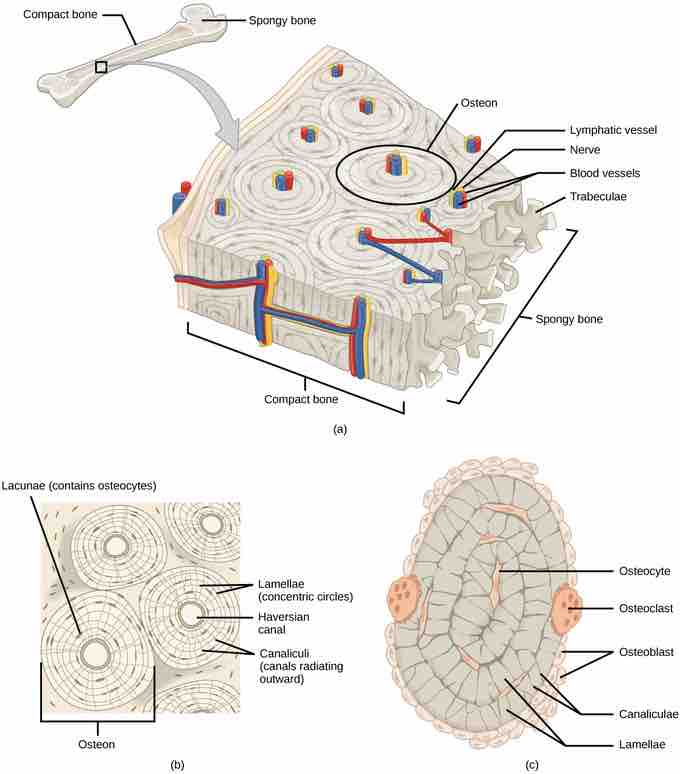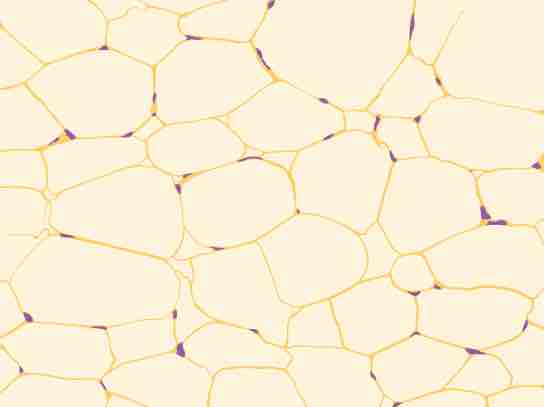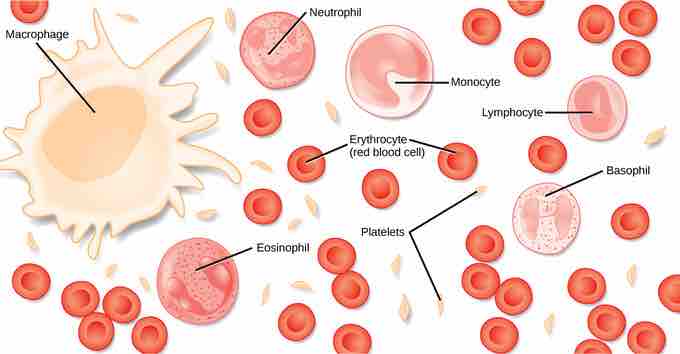Connective Tissues
Bone
Bone, or osseous tissue, is a connective tissue that has a large amount of two different types of matrix material. The organic matrix is materially similar to other connective tissues, including some amount of collagen and elastic fibers. This gives strength and flexibility to the tissue. The inorganic matrix consists of mineral salts, mostly calcium, that give the tissue hardness. Without adequate organic material in the matrix, the tissue breaks; without adequate inorganic material in the matrix, the tissue bends.
There are three types of cells in bone: osteoblasts, osteocytes, and osteoclasts. Osteoblasts are active in making bone for growth and remodeling. They deposit bone material into the matrix and, after the matrix surrounds them, they continue to live, but in a reduced metabolic state as osteocytes. Osteocytes are found in lacunae of the bone and assist in maintenance of the bone. Osteoclasts are active in breaking down bone for bone remodeling, providing access to calcium stored in tissues in order to release it into the blood. Osteoclasts are usually found on the surface of the tissue.
Bone can be divided into two types: compact and spongy. Compact bone is found in the shaft (or diaphysis) of a long bone and the surface of the flat bones, while spongy bone is found in the end (or epiphysis) of a long bone. Compact bone is organized into subunits called osteons. A blood vessel and a nerve are found in the center of the osteon within a long opening called the Haversian canal, with radiating circles of compact bone around it known as lamellae. Small spaces between these circles are called lacunae. Between the lacunae are microchannels called canaliculi; they connect the lacunae to aid diffusion between the cells . Spongy bone is made of tiny plates called trabeculae, which serve as struts, giving the spongy bone strength.

Bone structure
(a) Compact bone is a dense matrix on the outer surface of bone. Spongy bone, inside the compact bone, is porous with web-like trabeculae. (b) Compact bone is organized into rings called osteons. Blood vessels, nerves, and lymphatic vessels are found in the central Haversian canal. Rings of lamellae surround the Haversian canal. Between the lamellae are cavities called lacunae. Canaliculi are microchannels connecting the lacunae together. (c) Osteoblasts surround the exterior of the bone. Osteoclasts bore tunnels into the bone and osteocytes are found in the lacunae.
Adipose (Fat) Tissue
Adipose tissue, or fat tissue, is considered a connective tissue even though it does not have fibroblasts or a real matrix, and has only a few fibers. Adipose tissue is composed of cells called adipocytes that collect and store fat in the form of triglycerides for energy metabolism . Adipose tissues additionally serve as insulation to help maintain body temperatures, allowing animals to be endothermic. They also function as cushioning against damage to body organs. Under a microscope, adipose tissue cells appear empty due to the extraction of fat during the processing of the material for viewing. The thin lines in the image are the cell membranes; the nuclei are the small, black dots at the edges of the cells.

Adipose tissue
Adipose (fat) is a connective tissue composed of cells called adipocytes. Adipocytes have small nuclei localized at the cell edge and store fat for energy usage.
Blood
Blood is considered a connective tissue because it has a matrix. The living cell types are red blood cells, also called erythrocytes, and white blood cells, also called leukocytes . The fluid portion of whole blood, its matrix, is commonly called plasma.

Blood Tissue
Blood is a connective tissue that has a fluid matrix, called plasma, and no fibers. Erythrocytes (red blood cells), the predominant cell type, are involved in the transport of oxygen and carbon dioxide. Also present are various leukocytes (white blood cells) involved in immune response.
The cell found in greatest abundance in blood is the erythrocyte, responsible for transporting oxygen to body tissues. Erythrocytes are consistently the same size in a species, but vary in size between species. Mammalian erythrocytes lose their nuclei and mitochondria when they are released from the bone marrow where they are made. Fish, amphibian, and avian red blood cells maintain their nuclei and mitochondria throughout the cell's life. The principal job of an erythrocyte is to carry and deliver oxygen to the tissues.
Leukocytes are white blood cells of the immune system involved in defending the body against both infectious disease and foreign materials. Five different and diverse types of leukocytes exist, but they are all produced and derived from a multipotent cell in the bone marrow known as a hematopoietic stem cell. Leukocytes are found throughout the body, including the blood and lymphatic system.
Different types of lymphocytes make antibodies tailored to the foreign antigens and control the production of those antibodies. Neutrophils are phagocytic cells that participate in one of the early lines of defense against microbial invaders, aiding in the removal of bacteria that has entered the body. Another leukocyte that is found in the peripheral blood is the monocyte, which give rise to phagocytic macrophages that clean up dead and damaged cells in the body, whether they are foreign or from the host animal. Two additional leukocytes in the blood are eosinophils and basophils, both of which help to facilitate the inflammatory response.
The slightly-granular material among the cells is a cytoplasmic fragment of a cell in the bone marrow. This is called a platelet or thrombocyte. Platelets participate in the stages leading up to coagulation of the blood to stop bleeding through damaged blood vessels. Blood has a number of functions, but primarily it transports material through the body to bring nutrients to cells and remove waste material from them.